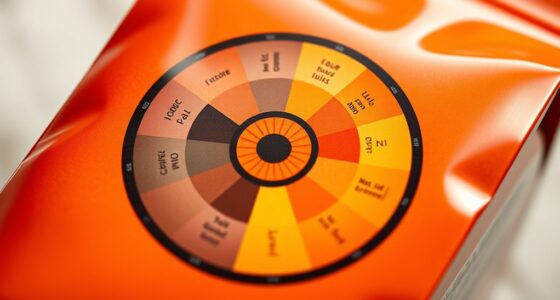When buying “espresso roast” bargains, look closely for visible defects like cracks, chips, uneven color, or mold. Smell for stale or sour aromas that hint at poor storage or age. Handle beans gently to avoid damage, and store in a cool, dark place. Prioritize reputable sources with transparent info and quality control. Avoid bulk or supermarket options. Keep these tips in mind to spot hidden flaws and guarantee a better espresso experience. Learn more to master this skill.
Key Takeaways
- Always inspect beans visually for cracks, uneven color, mold, and broken pieces before purchase.
- Smell beans for stale, sour, or fermented odors that indicate poor quality or improper storage.
- Prioritize buying from reputable roasters with transparent sourcing and roasting details, avoiding bulk supermarket options.
- Confirm beans are stored properly in airtight, cool, dark environments to maintain freshness and prevent defects.
- Be cautious of bargain prices; extremely low costs often signal defect-grade beans unsuitable for quality espresso.
Recognizing the Signs of Defect-Grade Beans

Recognizing defect-grade beans starts with examining their appearance carefully. Look for freshness indicators like dull, faded color or oily patches, which can signal stale beans or improper roasting. Fresh beans usually have a vibrant, even color, while defect-grade beans often display uneven roasting levels, with some areas over-roasted or under-roasted. Pay attention to cracks, broken pieces, or chipped beans, as these flaws suggest mishandling or poor quality. Smell also helps: stale beans emit a flat, sour odor instead of a rich, aromatic scent. Consistent roasting levels are key; defect beans may show inconsistent color or burn marks. Additionally, color accuracy in the appearance can help identify uneven roasting, since uniform color typically indicates better quality. By scrutinizing these signs, you can better identify defect-grade beans before brewing, ensuring your espresso maintains quality and flavor.
Common Flaws Found in Bargain Espresso Beans

When shopping for bargain espresso beans, you might notice visible defects like broken or uneven beans. These flaws often lead to unpleasant flavors and odors that can ruin your brew. Recognizing these common issues helps you avoid low-quality beans and guarantees a better espresso experience.
Visible Bean Defects
Visible bean defects are common indicators of lower-quality espresso beans and can considerably impact your final brew. During bean sorting, defect identification becomes essential to separate flawed beans from quality ones. Look for beans with cracks, chips, or uneven coloring, as these flaws suggest improper handling or poor quality. Discolored or stained beans often indicate mold or fermentation issues, while broken or misshapen beans can lead to inconsistent extraction. Spotting these defects early helps guarantee you’re not brewing with compromised beans that could produce sour, bitter, or flat flavors. By paying close attention to visible flaws, you can better select beans that will yield a richer, more balanced espresso. Remember, defect detection is your first line of defense against subpar coffee. Proper inspection techniques are vital for maintaining high-quality standards in your coffee selection process.
Unpleasant Flavors and Odors
Poorly processed or stored beans often carry unpleasant flavors and odors that can ruin your espresso. These issues are common with defect-grade beans and lead to flavor inconsistencies and odor problems. To identify these flaws, look for:
- Sour or musty smells indicating mold or improper storage.
- Burnt or smoky odors from overroasted beans.
- Fermented or cheesy scents suggesting fermentation flaws.
- Flat or stale flavors hinting at old or poorly stored beans.
Additionally, storage conditions significantly influence the quality and aroma of your beans, making proper storage essential for maintaining freshness. These odor issues and flavor inconsistencies can mask the true character of your espresso, resulting in a disappointing cup. Always trust your nose and taste buds—if you detect any of these red flags, the beans are likely compromised and unsuitable for a quality espresso shot.
How to Assess Bean Quality Before Purchasing

Before purchasing beans, it’s vital to evaluate their quality to guarantee a good espresso roast. Start by inspecting the beans’ appearance—look for uniform size and color, which indicate proper roasting consistency. Avoid beans with cracks, broken pieces, or irregularities, as these can signal poor handling or storage issues. Check the packaging or ask about bean storage; fresh beans should be stored in airtight containers away from light and heat. Smell the beans—fresh, high-quality beans emit a rich, roasted aroma, while stale or defect beans often have sour or off-putting odors. When buying in person, perform a visual and tactile inspection, and trust your nose. Additionally, understanding defect‑grade beans can help you identify inferior quality options. These steps help guarantee you’re selecting beans that will produce a flavorful, high-quality espresso shot.
The Impact of Defect Beans on Espresso Flavor

Defect beans can considerably undermine the flavor of your espresso, often introducing unwanted tastes and aromas that detract from the overall quality. They may cause sourness, bitterness, or off-notes that mask the true flavor profile. This impacts your espresso’s aroma, body, and aftertaste. Additionally, defect beans can shorten the shelf life of your coffee, as flaws accelerate staling. Here are four key effects:
- Altered flavor balance, skewing the intended roast profile
- Reduced aroma complexity and freshness
- Inconsistent extraction due to uneven roasting levels
- Limited shelf life, leading to stale, flat espresso over time
Avoiding defect beans ensures you maintain ideal flavor, preserve the proper roasting level, and maximize freshness for a better espresso experience.
Tips for Buying Budget-Friendly Espresso Beans Wisely

When shopping for budget-friendly espresso beans, it’s important to spot defect-grade indicators like uneven roasting or broken beans. Always buy from reputable sellers who provide clear quality information and reviews. These steps help you get the best value without sacrificing too much quality.
Recognize Defect-Grade Indicators
Recognizing defect-grade indicators is essential when buying budget-friendly espresso beans, as these signs can help you avoid poor quality beans that might compromise your brew. Being aware of these cues supports your sourcing strategies and helps you make smarter pricing considerations.
To spot defect-grade beans:
- Uneven or dull color—indicates inconsistent roasting or age.
- Broken or chipped beans—signs of rough handling or poor storage.
- Foreign matter or debris—suggests subpar processing.
- Visible mold or insect damage—a clear quality red flag.
Choose Reputable Sellers
Choosing reputable sellers is a key step in ensuring you get quality beans at a budget-friendly price. Look for vendors committed to sustainable sourcing, which often indicates better quality and ethical practices. Reputable sellers typically provide transparent information about their beans’ origin and processing methods. Pay attention to their roasting techniques; those who share details about their roasting process are more likely to produce consistent, well-crafted espresso beans. Avoid sellers that hide their sourcing info or offer suspiciously low prices without explanation. Reading reviews and seeking recommendations can help you identify trustworthy sources. By choosing sellers who prioritize transparent practices and quality roasting, you increase your chances of buying budget-friendly beans that taste great and meet your standards.
Storage and Handling to Maintain Bean Quality

To preserve the quality of defect-grade beans for espresso, proper storage and handling are essential. Good bean storage keeps beans fresh and prevents deterioration. Use airtight containers in a cool, dark place to avoid exposure to light, heat, and moisture. Handle techniques matter; always handle beans gently to prevent damage that could affect flavor. Consider these steps:
- Store beans in opaque, airtight containers.
- Keep the beans away from direct sunlight and heat sources.
- Avoid frequent opening to minimize exposure to air.
- Handle beans carefully to prevent crushing or breaking during transfer.
Following these practices ensures your beans stay fresh longer, maintaining their flavor profile and quality, even if they’re defect-grade. Proper storage and handling make a noticeable difference in the final cup.
Where to Find Reliable Sources of Quality Espresso Beans

Finding reliable sources of quality espresso beans starts with knowing where to look. Focus on reputable roasters and specialty coffee shops that prioritize transparency about their coffee brewing practices and roast profiles. Look for vendors who specify their beans’ origin, processing methods, and roast levels, as these details impact flavor and consistency. Online specialty retailers often provide detailed descriptions and customer reviews, making them a good choice for quality assurance. Avoid generic supermarkets that sell bulk or defect-grade beans, which may compromise your espresso’s taste. Instead, seek local roasters or trusted online sources that prioritize freshness and quality. By choosing sources committed to quality, you’ll ensure your espresso brew consistently meets your expectations, regardless of the roast profile. Additionally, paying attention to essential oils and aroma quality can help you select beans with desirable aromatic profiles that enhance the overall espresso experience.
Frequently Asked Questions
How Can I Differentiate Between Genuine Espresso Roast and Defect-Grade Beans?
To tell genuine espresso roast from defect-grade beans, you should perform a thorough bean inspection, looking for uniformity in size, color, and aroma. Genuine espresso beans typically have a rich, glossy surface and a consistent roast level. Pay attention to flavor differences during tasting; defect-grade beans often taste flat, sour, or off-notes. Being vigilant about these signs helps guarantee you select high-quality beans for the best espresso experience.
Are There Specific Brands Known for Selling High-Quality Budget Espresso Beans?
When looking for budget coffee, you want quality brands that deliver good flavor without breaking the bank. Some well-known names like Lavazza, Lavazza, and Illy offer affordable options that maintain quality. Shop around, read reviews, and try smaller bags first to make sure you get a genuine espresso roast. These brands are trusted for providing reliable, budget-friendly espresso beans that meet your expectations without sacrificing taste.
What Are the Health Risks Associated With Consuming Defect-Grade Coffee Beans?
Like walking through a minefield, consuming defect-grade coffee beans can pose health risks. You might unknowingly expose yourself to toxins or mold that can cause allergic reactions, digestive issues, or even more severe health implications over time. These beans may contain mycotoxins or other contaminants, increasing your toxin exposure. It’s essential to be aware of these risks to protect your health and choose higher-quality, safer coffee options.
How Does Roasting Level Affect the Visibility of Bean Flaws?
Roast color markedly impacts flaw visibility on coffee beans. Lighter roasts reveal more surface details, making flaws easier to spot, while darker roasts obscure imperfections with caramelization and oil. As you roast, you’ll notice flaws become less visible with deeper color, but they still affect flavor. Understanding how roast level influences flaw visibility helps you select beans that meet your quality standards, especially when aiming for consistent espresso quality.
Can Defect-Grade Beans Be Safely Used for Other Brewing Methods Besides Espresso?
You can definitely use defect-grade beans for alternative brewing methods like French press or pour-over. While they might not deliver the same clarity and flavor as higher-grade beans, you can still achieve enjoyable results with proper brewing adjustments. Experiment with grind size and extraction time to enhance flavor, and consider blending them with higher-quality beans for better aroma and taste. This way, you optimize your brew despite the flaws.
Conclusion
Just like a master painter chooses only the finest colors, you should select beans that promise a vibrant, flawless brew. By recognizing defect-grade beans and making informed choices, you’ll turn your espresso into a masterpiece—rich, balanced, and full of character. Don’t let bargain pitfalls dim your craft; instead, seek quality with the precision of a seasoned artist. Your perfect shot awaits, ready to bring your coffee canvas to life.









